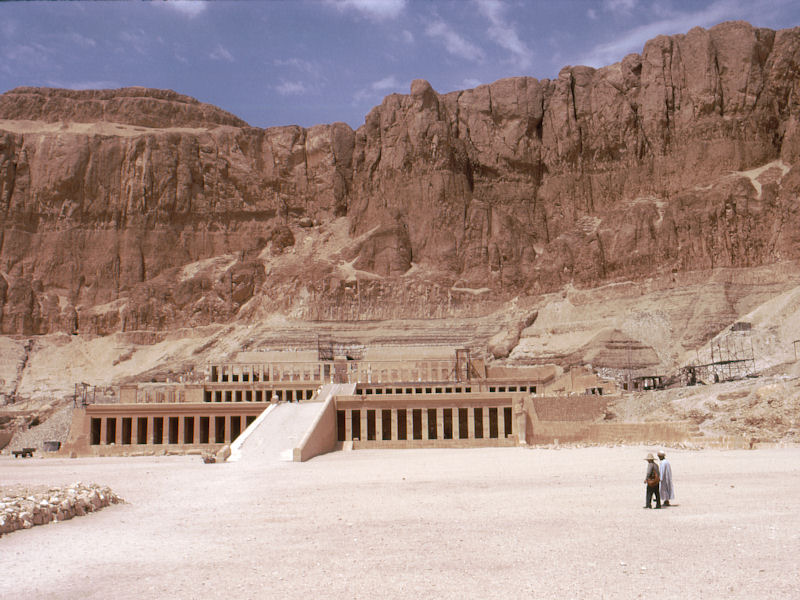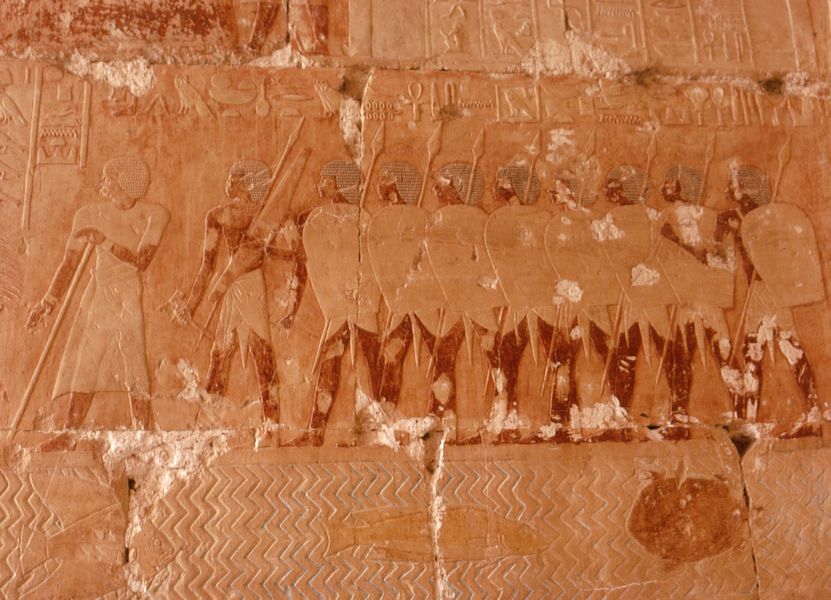Photo
album: "Thebes: The Necropolis"
Fly
over a photo with the mouse to enlarge it
Click
on a photo to open it in a new window
On
Saturday 5 April, in the afternoon we take the train to Luxor which we join in
the evening. Luxor is located on the site of Ouaset the city of ancient Egypt
which was renamed Thebes by the Greeks. On the east bank of the Nile are the
temples of Karnak and Luxor and on the west bank of the Nile lies the great
necropolis, or "City of the Dead". We cross the Nile on the morning of
Sunday, April 6 to visit the necropolis. In the Valley of the King we visit the
funerary temples of Ramses VI and Sethi I, as well as that of Tutankhamen (in
which it will not be possible to make pictures). We then go to Deir el-Bahari to
see the funerary temple of Queen Hatshepsut. Later, in the Valley of the Queens,
we visit the tomb of a son of Ramses III and finally we stop before the Colossi
of Memnon before crossing the Nile to return to our hotel.
 |
We are in the Valley of the Kings
where the tombs of most pharaohs of the New Kingdom, from Tuthmosis I to
Ramses XI (approximately -1539 to -1075) are located. |
 |
Here we are before a fresco in the
tomb of Ramses VI. He is the fifth pharaoh of the twentieth dynasty of
ancient Egypt. He reigned from -1145 to -1137 approximately.
|
 |
Fresco in the tomb of Ramses VI. |
 |
Fresco in the tomb of Ramses VI. |
 |
Fresco in the tomb of Ramses VI. |
 |
Fresco in the tomb of Ramses VI. |
 |
Fresco in the tomb of Ramses VI. |
 |
Fresco in the tomb of Ramses VI. |
 |
Here we are before a fresco in the
tomb of Sethi I. He is a pharaoh of the XIXth dynasty, who reigned from
-1294 to -1279. Son of Pharaoh Ramses I, he is the father of Pharaoh
Ramses II. |
 |
Fresco inside the tomb of Sethi
I.. |
 |
Fresco inside the tomb of Sethi I. |
 |
Fresco inside the tomb of Sethi I. |
 |
Back to sunlight, Marie-France and
our guide. |
 |
In a neighboring village, two
craftsmen make souvenirs for tourists. The one on the right digs a piece
of alabaster, partly buried in the ground, to make a vase.
|
 |
General view of the village. |
 |
We are now in front of the
funerary complex of Deir el-Bahari where we visit the palace of Queen
Hatshepsut (XVIIIth dynasty, New Kingdom, she reigned from -1479 to
-1457). |
 |
The Palace of Queen Hatshepsut. |
 |
Fresco in the palace of Queen
Hatshepsut. |
 |
Columns and statues in the palace
of Queen Hatshepsut. |
 |
In the palace of Queen Hatshepsut. |
 |
Fresco in the palace of Queen
Hatshepsut. |
 |
We are now in the valley of the
Queens. It is the necropolis of royal wives, daughters, sometimes sons of
the kings of the nineteenth and twentieth dynasties. |
 |
We are now in front of a fresco in
the tomb of one of the sons of Ramses III. |
 |
Fresco in the tomb of the son of
Ramses III. |
 |
Fresco in the tomb of the son of
Ramses III. |
 |
Before crossing the Nile to return
to our hotel, we stop in front of the Colossi of Memnon. These two
monolithic sculptures represent the pharaoh Amenhotep III. The left statue
with its pedestal, half buried, is 17 meters high and has a mass of 1305
tons. These two statues stood on the forecourt of the temple of the
millions of years of Amenhotep III. |
Go
back
.
.
.
.
.
.
.
























